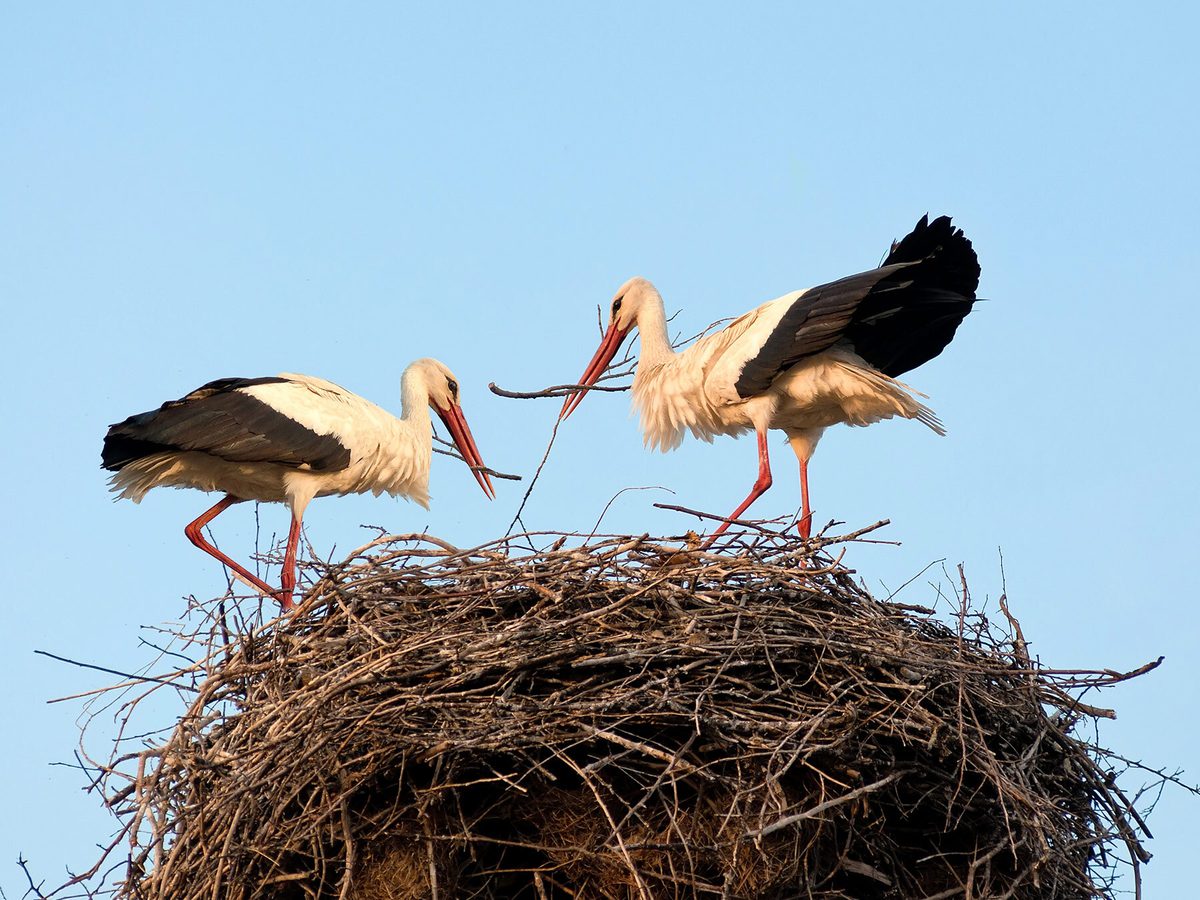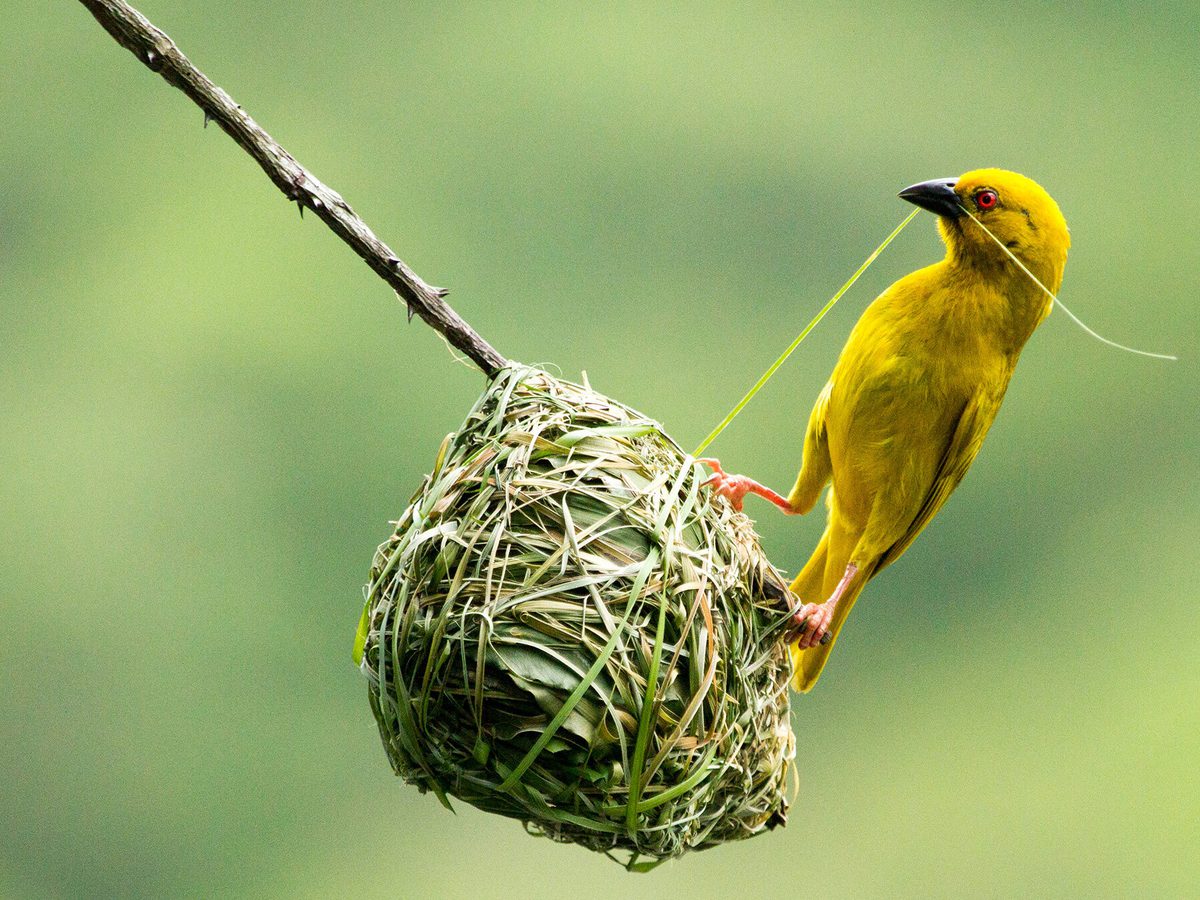Jump to Section
How Do Birds Build Nests? (5 Key Types)
Last updated: 4 November 2024

Nest-building is a complicated business, and there’s no “one size fits all” design. Some species work together, while for others either the male or female takes control, from selecting a site, gathering materials, and the actual construction.
Read on to find out more about construction techniques as we look in depth at answering the question: how do birds build nests?
Birds need a safe, secure place in which to lay their eggs. Nests need to be strong enough to endure incubation and raising of hatchlings until they fledge. A range of styles are used by different species, including cup-shaped nests, woven nests, twig platforms, cavities, and scrapes on the ground.
Some birds build elaborately crafted nests, while for others, a simple scrape on the ground will suffice. Materials used will depend greatly on what is available nearby, the size and dexterity of the species.
Some birds will give old nests an overhaul and reuse for subsequent broods, while others will start from scratch for each new clutch and may abandon nest-building to start again if they (or their mate) are not satisfied with their efforts.
Using only their beaks and sometimes feet to collect and transport materials, birds then craft, weave, pack, smooth, stack and shape their nests, taking between a day or two to three weeks or more to complete the job.
Read on to find out more about some of the more ambitious nest designs used by some birds, and discover just how they learn these architectural skills.

Two white storks building a nest together for their young
Different types of nests
Nests need to be sturdy enough to support a brood full of increasingly lively chicks, and withstand wind and heavy rain.
Location affects the materials that are available and the site chosen is affected by the bird’s instinct to build in the safest, most sheltered location it can find.
Below, we take a look at some common types of birds’ nests.
Cup nests
A classic style of nest, cup-shaped constructions are used by many backyard birds, including American robins, warblers, finches, and cardinals. Females select the site, typically supported by branches at the fork of a tree or deep in shrubbery or hedgerows. Construction is usually by the female alone, while males may help by bringing twigs and other materials.
A loose round frame of sticks, twigs, and grass is shaped together, and held in place by mud. The interior is pressed into a cup shape by the bird’s wings and beak, before being lined with moss, soft plant parts, feathers, or animal fur. Construction typically takes no longer than a week.

The cup-shaped nest of an American Robin
Woven nests
Weaver birds and orioles create some of nature’s most intricately woven nests, using grasses, straw, and even spiders’ webs to structure their dwellings. A highly complex process of knotting and interlacing is undertaken over the course of several days, with individual blades of grass being threaded together to form hanging domes or pouch-shaped shelters.
In weaver birds, the male takes charge of nest creation, and a female will select a mate on the basis of which construction impresses her most with its design and sturdiness. Male orioles may help supply nest-building materials, but the weaving is undertaken by the female alone, over the course of between 12 and 15 days.

Eastern Golden Weaver building a nest
Cavity nests
Woodpeckers, nuthatches, and some waterbirds such as wood ducks are known for cavity nesting. Some will excavate a new hollow in a decaying tree trunk, while others will make use of a disused cavity that has been utilized in the past by another bird.
It can take a male woodpecker between a few days to a couple of weeks to complete the excavation task, after which a lining of down and feathers may be added for comfort when laying and hatching begins.

Pileated Woodpecker chick looking out of the cavity nest
Pellet nests
Swallows, house martins, and purple martins construct cup-shaped nests using up to 1,000 pellets of wet mud. Pairs work together to create the nest against a vertical surface, such as a wall or the underside of a bridge, over a period of up to three weeks. Old nests may be reused in subsequent years, and repairing an existing nest is preferable to starting afresh.

The pellet nest of a Barn Swallow
Giant nests
Storks, herons, and many birds of prey, such as bald eagles and ospreys, build large, messy platforms using strong sticks, lined with leaves, or smaller twigs. Nests are shallow and have a slight dip where the eggs are laid. Nest-building is co-operative, with males sourcing materials and females doing the bulk of the building work.
Rooks are known for colossal, haphazard nests high up in tall trees. They identify a site in a fork between branches and fly over it, repeatedly dropping sticks. Many sticks fall, but some stay in place, and gradually develop into a bulky nest which is then lined with softer leaves and feathers.

The giant nest of a Bald Eagle
How long does it take for a bird to build a nest?
Nest-building can take anywhere between a couple of days and three or more weeks. A simple scrape on the ground is ready almost as soon as a site has been identified, and barely lined with twigs and grass. Nightjars do not even go this far, laying eggs directly on the forest floor.
Simple platforms, constructed by doves and pigeons, take minimal building time and effort, and are complete within a matter of days. However, these flimsy nests often fail and construction needs to start from scratch.
Elaborate nests take longer to craft: house martins’ clay nests take up to three weeks to perfect, while it can take a weaver bird up to four weeks to complete its painstakingly interwoven construction.

The nest of a house martin
How do birds know how to build nests?
Whether a bird instinctively knows how to build a certain style of nest or whether it’s a learned skill is the subject of much research.
One theory is that birds are born with the innate ability to craft a certain type of nest. Others believe that birds study empty nests which gives them an understanding of what is needed and what works before they begin constructing their own.
Findings indicate that ‘practice makes perfect’ with many early nest attempts being abandoned in favor of later nests that are constructed using improved techniques that have been learned from experience.
How many times will a bird try to build a nest?
Some birds, including the Australian Willie wagtail, have a reputation as perfectionists and will destroy a nest midway through construction if they are not happy with their progress and reuse the materials to start again. If a nest fails early on in construction, birds will instinctively begin again until it goes according to plan.

Willie Wagtail sat in the nest
What do birds do when their nest is destroyed?
A number of reasons can cause a bird’s nest to be destroyed, including severe weather, being raided by predators or accidental (or even deliberate) human activity. Birds may react in different ways, depending on whether they have nestlings that need care, or how late in the breeding season it is.
Many birds will abandon the nest altogether and rebuild elsewhere. Cavity nesters will look for a new hole in a different tree. Some birds may attempt to repair a damaged nest or reuse material from their initial nest to construct a new one, but if the entire nest has been destroyed, including any unhatched eggs or young chicks, the only option is to start over.
Certain species, such as northern cardinals, create two nests in a breeding season to cope with multiple broods, and if one of their nests is destroyed, they will simply relocate to the second one.

A female Northern Cardinal gathering nesting materials
Will a bird return to a disturbed nest?
If a bird senses that its nest and eggs are under threat, it will likely desert the site and start again elsewhere. If a potential predator disturbs the nest, the bird will feel too unsafe to continue with attempting to raise chicks there. Any unhatched eggs will be abandoned, and the bird will not return to continue with incubation.
The instinct to protect young is strong in most birds, particularly the closer they get to fledging.
Most birds are not capable of carrying their young to a new nest site, and unless the threat is ongoing and severe, the mother is more likely to stick around and do all she can to safeguard her chicks.
Materials you can leave out to help birds build nests
Placing plant cuttings, dried grass and natural fibers in a hedge or in a hanging basket, will allow nesting birds to swoop in and pick out anything that catches their eye.
Muddy pools or puddles are welcomed by robins, phoebes and barn swallows, which use wet mud to construct their nests.
It’s not recommended to leave out pet fur or human hair. The fur of pets that have been treated with chemicals for fleas or worms may be toxic to birds, and according to research, has caused deaths of nestlings. Human hair, with traces of shampoo and other products, may also be unsafe for birds.

House Martin gathering mud for nest construction
On this page
- Different types of nests
- How long does it take for a bird to build a nest?
- How do birds know how to build nests?
- How many times will a bird try to build a nest?
- What do birds do when their nest is destroyed?
- Will a bird return to a disturbed nest?
- Materials you can leave out to help birds build nests

